- Let me begin with an interview talking about your background. When and why did you join Esplanade?
-
My interest in the arts started from as early as the late 1970s. However, at that time, there was no professional industry, especially in the field of theatre, in Singapore. Then, I worked as a teacher of English literature and in my spare time, I would produce plays with friends. The arts was something you did in addition to your day job, it was not a professional career choice.
In the 90s, I finished my postgraduate degree receiving an MA in English literature and learned that Esplanade project had been started. The Report of the Advisory Council on Culture and the Arts was submitted to the government in 1987 and it recommended that the government set up a company to develop an arts centre – which was called Singapore Arts Centre then – alongside with the establishment of the National Arts Council. This arts centre was to be managed independently rather than as a state owned and managed “national theatre.” (*1) In 1992 the Singapore Arts Company was formed to take charge of the development and management of the centre, this was subsequently renamed “The Esplanade Co. Ltd.” in 1997.
I joined in the company in 1997 to continue my interest in the arts. Having been here for the last 10 years, even before the centre was constructed, I guess you could say I am one of the , “original” members of Esplanade. - I understand there were occasions of discussions with local artists about the visions of Esplanade before the project started. For example, I read that the first design brief submitted in 1987 was made with the consideration of the voices from local arts community. What was the important input from them? What was realized based on their opinions?
-
Being an arts centre for the people, local voices were key in its development as we were being built precisely to meet their needs. I think the input from the local theatre community contributed in two ways. One was the introduction of Asian elements in two areas- the physical design of the space and also in terms of the centre’s programming.
The other was stressing the importance of developing a centre where local artists could work. Esplanade has four venues, namely the Main Theatre, the Concert Hall, the Theatre Studio and the Recital Studio (*2) . If there was only a big theatre and a concert hall, the number of the local artists who could use these spaces would be very limited. The input from the local arts community led to the creation of our two studio spaces, which could cater for different types of works than the large halls. This resulted in the Theatre Studio and Recital Studio within Esplanade - This complex is an impressive combination of theatres, shopping malls and public spaces such as the library. As a result, I think, it became a place where people gather naturally. Was this a concept of the design from the very beginning?
- Yes, right from the beginning. We did not want to make it just a theatre. We hoped to create a place where people gather before and after the show. The arts are vibrant and similarly we wanted an environment that reflected that. A centre alive with people where the buzz of ideas could be debated and generated
- And you are now the Director of Programming at Esplanade. How does the programming work?
-
We have a very wide range of programs. That is a part of our vision statement, which is “Esplanade will be an arts centre for everyone” to ensure that we meet the needs of the community we are meant to serve. The presentations that take place here can be broadly categorised as such- “Esplanade Presents” programs which we produce ourselves and programs presented by external hirers of our spaces. The “Esplanade Presents” programs consist of the following three categories according to the forms and purposes. 1) “Festivals” that help us celebrate cultural events through the arts and also festivals that are focused on specific genres or art forms. This helps us celebrate our culture and also introduces and familiarises audiences with specific art forms and genres, 2) “Series” which aims to develop both audience and artists by continuous exposure to the programs, and 3) “Free/Access Programs” aiming to allow us to reach more audiences, especially those yet to be enticed by the arts by presenting free or low-priced shows. If we add the 4) outside, “non-Esplanade Presents” productions which tend to take on more commercial and mass appeal works, we have four pillars in our programming structure.
When we planned the arts centre in Singapore, of course we all had dreams regarding it. Looking at the places like New York, London and even Japan, they have so many different spaces, so many different centers and each of them is specialised in different things. In London, for example, if you are looking for certain kinds of theatre productions, you can go to the National Theatre in South Bank or Barbican. If you want a more commercial kind of thing, you can go to the West End. But, in Singapore, this is not the case. We don’t have many spaces. That’s why we had to think about it from the opposite side. We realised that Esplanade, as a publicly funded project, is built for everybody and must belong to everybody. Once you say it belongs to everyone, there have to be different programs for different people.
The other important point we have to take into consideration, I think, is this: Unlike many other societies, Singapore is a very multi-racial society. Because of that, when we say “Esplanade belongs to everyone”, we have to assume that it cannot belong to any particular ethnic group. Our philosophy, “arts centre for everyone” is not a superficial one – we have tried to create programs for every ethnic group and community. And that is why we have many festivals celebrating the traditions of different ethnic groups in Singapore, such as Indian, Malay and Chinese Festivals. - You pointed out that there were not various performance venues in Singapore when the project of Esplanade started. However, we can find quite a number of theatres here now in 2007. Even since the opening of Esplanade in 2002, several large and small theatres have been built. How do you posit Esplanade in the large picture of performing arts industry in Singapore?
-
To answer this question you need to understand that most of the other venues in Singapore, such as new Drama Centre and the Victoria Theatre, are theatres to be hired – they don’t have programming departments. The first thing we decided when planning Esplanade was not to make it solely for hire [rental]. We would lose our control of programming of the venue if we did.
This is an important difference in two ways. Firstly, without the programming capability, we cannot realise our vision as an “arts centre for everyone.” What would happen if, for example, we got offers only from Chinese theatre companies? We still should think about programs for other ethnic groups, but it would be very difficult if we could not control the programming. I believe the ability to control programming lets Esplanade complete our mission and makes us different from others.
Secondly, the programming gives us an identity or character. Without a concrete identity, a new venue cannot be an “arts centre.” And, the arts centre becomes important because of the responsibility we bear – in terms of the arts and culture created there. You are never passive. We are here to create and develop the culture of Singapore. - Practically speaking, how do you manage the programming of Esplanade? Can you explain about your team?
-
Because we have a wide range of programs, it is impossible to have a single person who is familiar with all the different genres. Rather, some specialise in experimental theatre, others are more interested in programs for older people, such as popular music of 50s and 60s. And some are familiar with Chinese culture and some are good in Malay arts. Each of us is strong in different areas. So, what we need to do is to form teams with people who are specialised in particular areas.
Depending on the nature of the program, we have teams that vary in terms of the size. Sometimes we have small teams within a big team. The formation of the teams is very flexible. At the moment, we have about 20 programming staff. They do not necessarily have an educational background in arts management. Sometimes their passion for the arts is more important than formal education. We hope to play a role of developing in Singapore programming officers and producers as well. The skills required for the producers are not limited to knowledge in the field of their specialty. A sense of marketing is also needed – how to price the show and how to market it to the audience. In other words, there are two parts of the job. One is related to the knowledge and the other is about how to present it. We are training our younger programming officers and hope to let them become producers eventually. Let me ask about the programs of each category, which you pointed out. Can you talk about the programming of the regular events, which fall into the first category, i.e. “Festival” and the second, “Series?” (*3) What are the things you keep in mind when preparing the program? -
All of our festivals have several parts and all fit together. For our main programs, of course, we need the finest quality productions. Whatever the genre of the festival, we always look for the best productions available, either internationally or locally. However, at the same time, we have to consider the people who usually don’t come to the theatre. People tend to think that arts are for educated or sophisticated people. However, what we are advocating here is the idea of “arts for everyone.” It does not matter who you are. We have free programs mainly targeted at these people. We seek a lot of community involvement during the festivals. Another way we do this is to work with community members on projects that can be a part of our festival. Thus far, these have taken the shape of visual arts projects tied into a festival theme which are then displayed at the centre. From here, community members start to feel a sense of affiliation with the centre, when they feel a stronger association with it. Another important component is the educational aspect, which consists of workshops and exchange programs so that visiting groups and artists have a chance to interact with local artists and audiences. All of these elements are combined within each festival.
The timing of the festivals is also important. For example, Huayi- Chinese Festival of Arts coincides with Chinese Lunar New Year. So, people come to celebrate the heritage – not just the tradition, but also the future. That’s why we have various productions – from traditional performances to contemporary works – in the festival. For example, last year’s Huayi festival had a contemporary dance performance by Taiwan’s Cloud Gate Dance Theatre, a multi-media production on the theme of traditional Chinese Opera by Zuni Icosahedron from Hong Kong, our own Toy Factory Theatre Ensemble’s contemporary theatre piece and traditional-oriented puppet theatre of the Taiyuan Puppet Theatre Company from Taiwan for children.
Another reason that we present such a wide range of programs is to illustrate that the arts are NOT only for a small group of people. We want to break down the distinction between the “high” arts and “popular” arts. For us, the “arts” means just “arts for everybody.” - In addition to these festivals, you have independent productions, which can be categorized as “Free/Access Programs” all through the year. (*4) What are the points you emphasize in programming them?
-
I think there are two parts to the objectives in our programming in this category. One is building an audience that enjoys arts regularly, and the other is nurturing artists – helping our newer artists and developing their ability.
Let us talk about the development of the audience first. What we consider most important is to make sure that Esplanade is accessible to everybody. There are people who cannot afford tickets – we hope to provide chances for these people to enjoy the arts, too. Therefore, we make sure that every Friday to Sunday we have free performances at the outdoor theatre. From Monday to Thursday you can enjoy free performances at our concourse. Everyday of the week you can come with your family and enjoy performances without spending money. This happens throughout the year. But, perhaps these outdoor performances are not enough. That’s why we have free concerts at our 1600-seat Concert Hall once a month on Sunday afternoons. We also have lunchtime concerts at the Concert Hall. And going beyond that, we are providing different kinds of performances for different objectives. Coffee Morning & Afternoon Tea is a series of concerts targeting mainly senior citizens. These are people who have a tendency to stay inside their house, all alone all day long. The concerts held in the morning and the afternoon on Mondays have become a good opportunity for them to go out and meet people, make friends and sing songs of the 1950s and 60s.
For the development of artists, we have a program called Late Night @ Esplanade , which takes place at the end of the month and is a programme that helps young artists present ticketed performances at Esplanade. This series also aims to nurture the younger audience. The performances by younger artists at the Concourse area are another example of how we give local artists more chances to perform at Esplanade. We have around 1,200 free performances a year and most of them are by local artists. There are also display spaces for visual arts along the underground passage linking us to the subway. These spaces are meant for the usage of young contemporary Singaporean visual artists. We are trying to boost the overall abilities and capabilities of Singaporean artists and arts companies. - How about the programs organized by outside parties, which fall into the fourth category? (*5) For example, The Phantom of the Opera had a 2-month run early this year. How do you find the possibilities of these large productions?
-
As an arts centre, we realised that it is not useful for us to try to program everything. Of course, it is true that we need to do certain kinds of things by ourselves to establish our position and make sure that our vision is realised.
But at the same time, there are productions that are very big, and very commercial in nature. What we do in such cases is to let external presenters who wish to present these shows rent our venues. I have a feeling that such possibilities are becoming bigger as the reputation of Esplanade has become established.
Apart from these , we have recognized that there are a number of up and coming arts presenters in Singapore. To develop a healthy arts industry in Singapore, I believe it is very important to let different parties present different kinds of things. Some present very commercial shows. But as long as the show is of good quality and is organised well, we can consider it something that meets our objective of an “arts centre for everybody.”
We sometimes collaborate with these outside presenters and help them to develop themselves. For example, for the “M1 Singapore Fringe Festival” we worked with a local theater company named The Necessary Stage in collaboration to present the festival. So, we are helping to develop the industry by helping these other parties. And, by working with them, we can add different perspectives in our programming, too. I would like to ask about your relationship with other countries and overseas organizations. At the moment, Singapore is almost the only country in Southeast Asia which has the capabilities to host international productions on a large scale. However, it is also true that we can see some developments in the neighboring countries recently. Do you see any possibilities to collaborate with your regional counterparts in the future? -
Definitely. Actually, we have had an experience working in a project called “Little Asia Dance Exchange Network” before. It was a collaboration among small venues in the region, such as the Hong Kong Arts Centre, the Sydney Opera House Studio, SIDance of Korea and the Taipei Dance Forum. We produced a small studio production and they toured with this new work.
Another example was the big-scale collaboration on I La Galigo , which was directed by Robert Wilson and premiered in 2004. It was an international collaboration project, which was realized with support from Change Performing Arts of Milan and the Bali Purnati Center for the Arts. I La Galigo , which is based on an epic poem of the Bugis people of South Sulawesi, featured more than 50 performers and toured to the United States, the Netherlands, Spain, France and Italy. We do collaborations both on the big-scale and small-scale. We are always looking for partners. Of course, several issues always matter, such as timing and budget and it should be a project that meets the expectations of the audience, too. - International collaboration seems to mean a lot for Esplanade. It was symbolic that the performance for the grand opening of the theatre in October 2002 was Reminiscing the Moon , a collaboration between Singapore Dance Theatre and the Indonesian choreographer, Boi Sakti.
-
Yes, it was a symbolic production because it was a kind of “official statement” on the identity of Esplanade. As a new arts centre in Southeast Asia, it was important for us to open the doors to the public with this kind of performance. It was an effective way to show who we are, where we are and what we are.
Singapore Dance Theatre is a contemporary dance company while Boi Sakti emphasises the traditional element. So, it meant everything for us – the region, our past and heritage, and at the same time, the contemporary situation.
During the Opening Festival in 2002, we had several other collaborations too. Singapore Repertory Theatre’s very successful musical, Forbidden City was a collaboration with the UK and in the field of music, and the Singapore Chinese Orchestra collaborated with a Chinese soprano. We are still keen on commissioning international collaborations. - Talking about the Opening Festival, the presence of Japanese artists was also significant. Gekidan Kaitaisha became the very first group to perform at the Theatre Studio, and a series of concerts titled AlterZone: A State of Mind featured Japanese artists in three productions out of six. How do you find the Japanese arts scene? And, how do you collect information about it?
-
In Asia, Japanese theatre has a longer history than that of most of other countries. I understand the arts in Japan are quite developed in every field – theatre, music and dance. We expect that we can get more from Japanese performing arts and will continue to look for good productions.
Regarding information collection, each of us in charge of programming has an area we are responsible for. We regularly let our staff members go out of the country to build our international network. - And Esplanade host the Asian Arts Mart for the fourth time this year (June 1-3, 2007). This is another of Esplanade’s initiatives in the networking area, isn’t it?
-
That’s right. In fact, this year’s Arts Mart was rather different from the previous ones. It was more focused on the artists. We created more opportunities for artists to get to know each other. We consider the artists to be delegates too, which is not very common in arts markets – usually only the presenters become the delegates and artists are there just for showcases.
In Asia, this new strategy should be useful. Most of our artists are emerging, developing and new. They can develop themselves by exchanging views and it will be mutually beneficial. We want the artists to have more interaction among themselves to watch each other’s works. This concept is something we are pioneering in the field of arts markets. Of course, we also want the presenters to know the artists and their works. - Asian Arts Mart is held during the period of this year’s Singapore Arts Festival. Esplanade hosts several Festival productions, but at the same time you have your own programs “in conjunction with Singapore Arts Festival” – Mechatoronica by Japan’s Maywa Denki is one of them. What is your relationship with the Festival?
- We are an independent company with no direct relationship with the National Arts Council, which is the organiser of Singapore Arts Festival. So, in cases where Singapore Arts Festival uses our venues for their programs, the Council is considered primarily as a hirer. However, because both of us share the national goal of making Singapore a culturally vibrant city, the actual preparations are done through close consultation with the National Arts Council. That is why we produce shows in conjunction with the Festival to create a festive ambience at Esplanade which will enhance the general festival buzz in the city at that time. These shows will have a lighter and quirkier character, and most of them take place for free at our open areas such as the concourse and the forecourt with some choice presentations at our indoor spaces as well. This year we featured Japanese group Maywa Denki. We hope that with all the bustle of activity, people who come here will feel, “Oh, this is the month of the Arts Festival.”
- It has been almost five years since the opening of Esplanade. What do you think has been your major achievement? And what do you expect in the future?
-
I think one of the biggest achievements is that we have helped to create an annual “arts calendar” in Singapore. Now people can expect specific kinds of arts events at specific times of the year. By introducing the “
da:ns
Festival,” an annual international dance festival last October, we completed a yearlong calendar of the arts. Thanks to this development, I believe we have been making strides in introducing the arts to quite a broad range of people who previously had not attended arts performances, and brought them to Esplanade. We have built a strong relationship with our local artists and the communities.
About the future… we are looking for many things. Although we have been working hard, we are still looking to develop further both the capabilities of artists and the sophistication of our programming. We hope especially to develop educational programs – programs for school children. You might have seen a lot of school children in Esplanade because one school visited us today. We have this kind of school visits regularly. However, there is still some room to enhance things further. For example, we can have more performances presented specifically for school children. It is very important, I think, to be familiar with theatre performances at the early age. With that kind of experience they can become regular theatergoers and supporters of the arts in the future.
JP Nathan
Speaking with the Director of Programming for the grand-scale arts and culture centre Esplanade, the symbol of Singapore’s "Renaissance City

JP Nathan
Director of Programming of the Esplanade
Singapore is a country working to promote arts and culture as a national agenda under its “Renaissance City” program, which positions the arts at the centre of national strategy that entails the establishment the state’s brand image and building economic competitiveness. The Report of the Advisory Council on Culture and the Arts , published in 1987, prompted the serious development of a scheme to support the arts, including the establishment of the National Arts Council under the Ministry of Information, Communications and the Arts.
As part of these programs, Esplanade – Theatres on the Bay opened its doors to the public in October 2002. Built on six hectares of land on Marina Bay near the center of the city, it is one of the largest theatre complexes in the Southeast Asian region. The complex hosted 1,915 performances (637 ticketed /1,278 non-ticketed) and had over 7 million visitors in Fiscal 2005/6, with an audience of about 1.4 million. This is equivalent to 30% of the market share of the arts industry audience in Singapore.
*1
A certain amount of Esplanade’s budget is from government grants. However, the usage of the grant money is under strict regulation and Esplanade is always requested to increase its income through its own efforts. Esplanade restructured its marketing department to strengthen the ability to gain sponsorship. The “Partners” of Esplanade are Volkswagen and Visa Card and a number of large and small companies are listed as sponsors (as of 2005). The breakdown of the income of Esplanade in Fiscal 2005 is as follows. ($,000) Venue hire and other rentals11,327Ticketing3,404Sponsorship and donations2,351Other Income2,586Grant from the government (including subvention of rental of property)38,136(Source: The Esplanade Annual Report FY 2005)
*2
The Theatre has a traditional opera-house design with a 2,000 seating capacity. Concert Hall, with an acoustic design by Russell Johnson can accommodate 1,600. Theatre Studio is a black box with flexible seating arrangement up to 220. Recital Studio is a space suitable for small concerts such as chamber music. This 245-seat studio can be used for corporate and private functions.
In addition to these venues, Esplanade has its Outdoor Theatre facing the waterfront and an open stage called Stage@Esplanade. Both of these are mainly used for free performances. The Concourse area is also used for free performances and visual arts exhibitions. The Esplanade Mall is a shopping mall on the 1st-3rd floors of the complex, which has various shops, restaurants and bars. Library@Esplanade, the only performing arts library in Singapore, is an anchor tenant of the Mall.
*3
“Festivals” are organized in three categories; 1) Culture Festivals showcasing the cultures of Singapore’s major ethnic groups, such as Huayi Chinese Festival of Arts , Kalaa Utsavam Indian Festival of Arts and Pesta Raya Malay Festival of Arts , 2) Community Festivals targeting a certain group of audiences such as children, elderly people and families. This category includes OctoBURST! celebrating the children’s day and Date With Friends targeting elderly citizens, and 3) Genre Festivals which focus on a particular genre, such as Mosaic Music Festival of jazz and world music, BayBeats alternative music festival and da:ns Festival which showcases wide variety of dance from traditional to contemporary. “Series” contains the ones which features international artists, such as Classics of classical music and Pedals & Pipes of organ music, and the ones which aim to develop local artists, such as the Theatre Studio Season of experimental theatre and Chinese Chamber Music .
*4
Free/Access Programs are held at various places in Esplanade, and the Concourse area and Outdoor Theatre facing the waterfront are the main venues. The performances at these two venues are presented serially and are named At The Concourse and On The Waterfront respectively. In addition to them, some series targeting particular audiences are also organized such as Coffee Morning & Afternoon Tea .
*5
There were 489 events organized by the outside parties in Fiscal 2005/6 and brought the income of $5.95 million to Esplanade. Musicals contributed to a large proportion. The line-ups of 2005 include a Broadway musical, Sound of Music and some local productions. In other genres, there were large-scaled productions of opera, dance and music. Nine performances of Singapore Arts Festival were also staged at Esplanade.
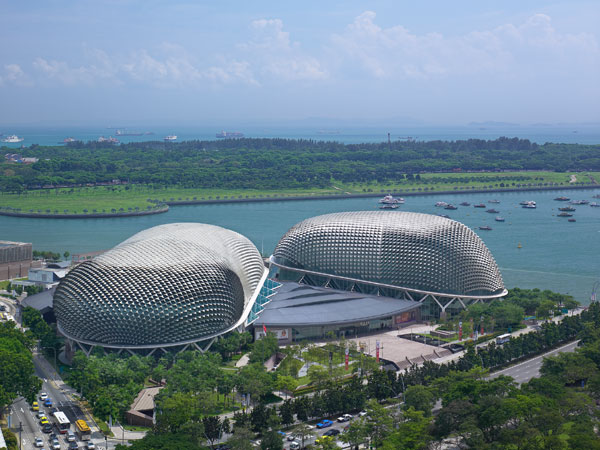
Esplanade – Theatres on the Bay
https://www.esplanade.com/
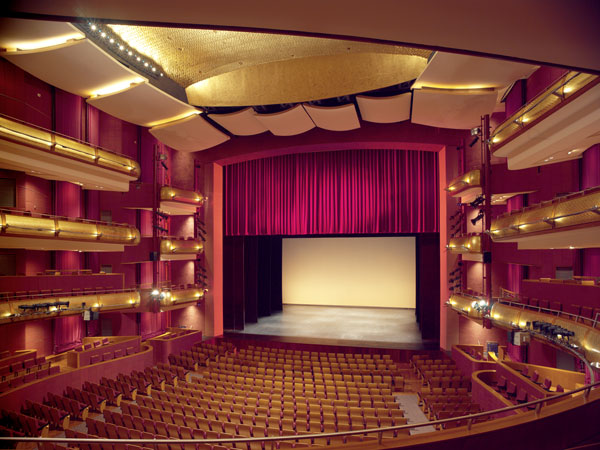
Theatre
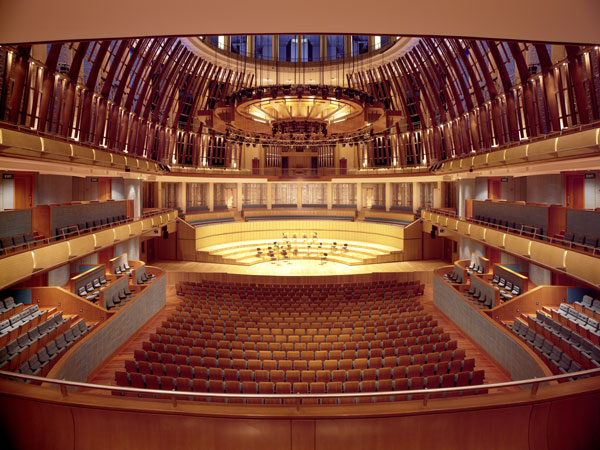
Concert Hall
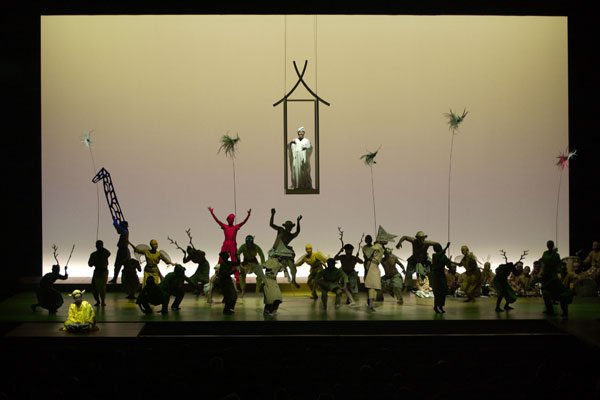
I La Galigo
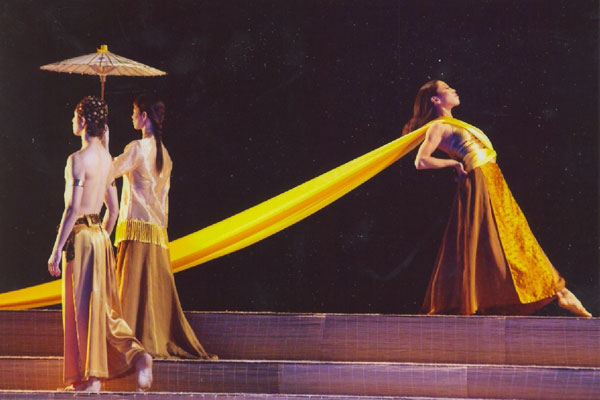
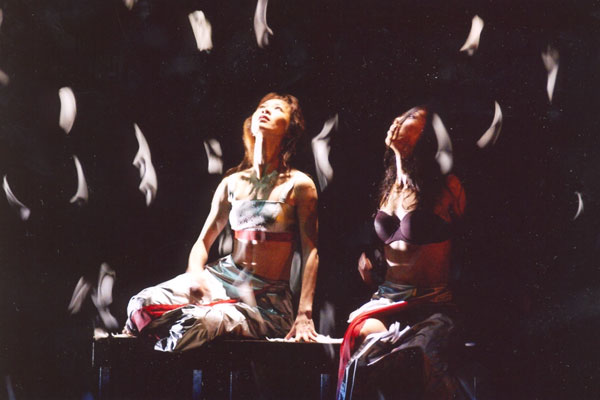
Reminiscing the Moon
Related Tags

